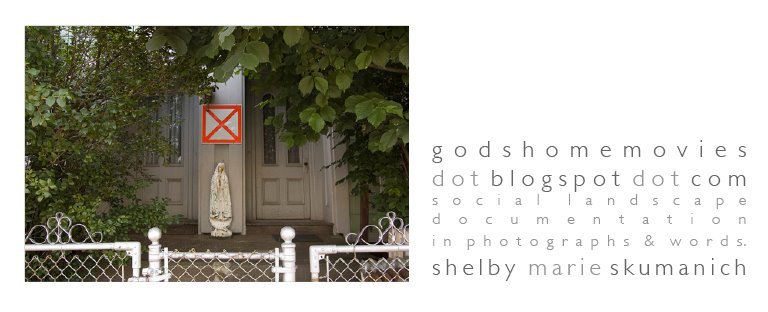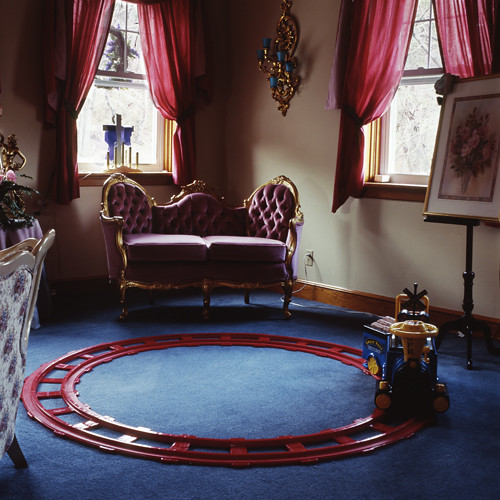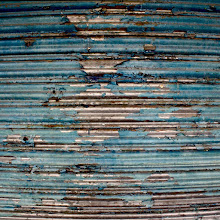These posts are no more than a glorified link dump. There will be six new ones every week. There is no logical order nor coherency.
01. Vanishing of the Bees. A film about the decline in the bee population. see also Allison Wallace's A Keeper of Bees.
02. Apophenia. A blog about e-life and it's impact on society. Interesting! Smart!
03. No Depression. A magazine that surveys the past, present and future of American music.
04. Switch Back Gravity Railroad. An effort to get the Switch Back up and running again. When I grow up, I will belong to a historical society.
05. A NYtimes story about Deer Hunting for Population Control in New Jersey. Interesting.
06. Laster's Art Shack. The Laster's are a family of three from Kentucky that produce phenomenal folk/outsider art. They are great artists and Ruby Elvis Rose is about the cutest thing you could ever imagine. Someday, I will have the pleasure to own one of their pieces or travel to see their homestead.
(Okay, Okay. It's not quite Saturday but I'm sleepy.)
2.12.2008
Six Links for Saturday.
Blinded By the Light.
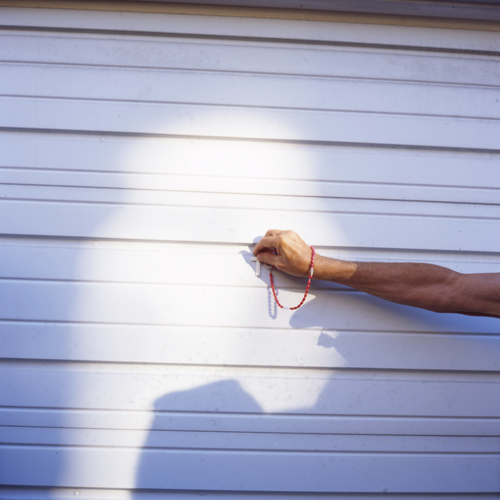
Image Drawing Faithful to Minersville.
In mid August, an image of what some described as the Virgin Mary appeared on a garage door on Lewis street, a narrow cracked alley way, in Minersville, PA. Hundreds of people came to see her, pray and bless various religious objects.
I drove to Minersville on August 29th and photographed the entire time she was "there", about 45 minutes. She slowly moved up the garage door as the sun set.
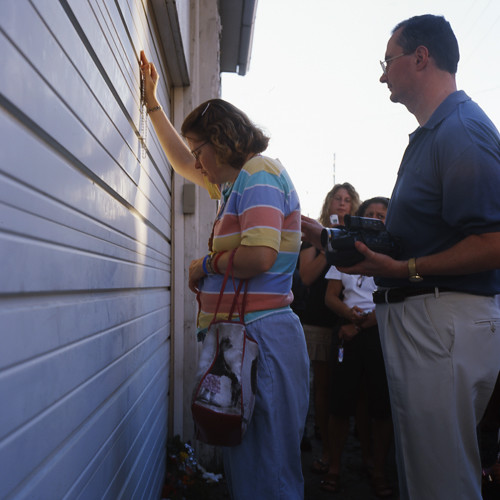
Before she arrived, the crowd of about 150 people buzzed and chatted quietly. One woman standing close to me passed around digital prints from the Rite-Aid up the street, noting the "supernatural" fog in the photos. Of it, she said "Digital cameras capture the energy around her better than film. I don't know what it is but they do." I glanced over her shoulder to notice the way the dirt on her camera lens was rendered in the photos. In the midst of the crowd whispering and snapping photos, I turned to the house across the street, noticed a large, shiny statue of the Blessed Mother in the second floor window and noted how the sunlight hit her just perfectly. I smiled to myself as I turned my eyes back to the crowd and to my ground glass.
at
8:54 AM
![]()
labels: pennsylvania, photography, silver, the coal region, the virgin mary
Minor Bird, Jazz Saxaphonist, Framingham MA.
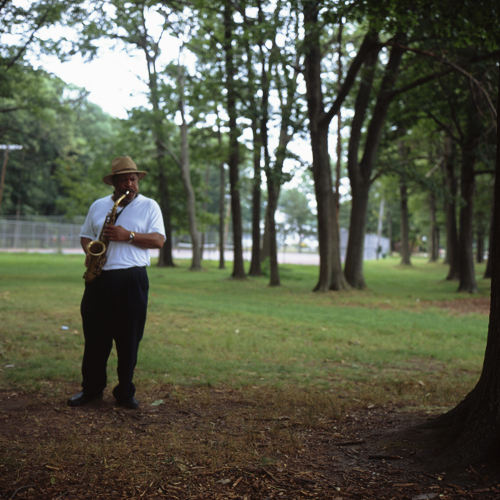
I had a chance with meeting with Minor Bird. I went to photograph a baseball diamond and a set of old bleachers that caught my eye. It was rainy and gray and cool for July. While I was approaching the park I heard jazz music, which seemed to be emanating from the trees. We eyeballed each other for the 15 or so minutes I was there until I walked up to him and said "What's up?"
at
8:38 AM
![]()
labels: massachusetts, photography, portraits, silver
2.11.2008
Little/Big Steel: Bethlehem

Photo Credit: Jeremy Blakeslee
Since I started a welding class three weeks ago, I've been thinking a lot about metal, about steel. I've found myself suddenly inspired by the noisy metal shop at Mass Art, thinking about what I can make from sheets of steel, what sort of object can come from something so solid.
It led my brain directly to Bethlehem Steel, the company that provided the steel beams for Rockafeller Center, the Crystler and Empire State Buildings, as well as the Hoover and Grand Coole Dams and the Golden Gate Bridge. It was the second largest steel mill in the United States, just after U.S. Steel out in Pittsburgh.
I could go on and on about the finer details of Bethlehem Steel but instead, for a brief overview, I'll direct you to the wiki page.
The land and structures left at the Bethlehem Steel Complex along the river are at the center of local controversy since it was sold in 2003 and then purchased by Sands Bethworks in 2007. Right now, construction is underway for a massive casino, another push in the direction to "culturally" and economically revive Bethlehem and the Leigh Valley. The casino is sought to bring millions in the Valley, to the South Side of Bethlehem. It is a complicated matter, as the part of the revenue from the casino is to go back into preserving the historical landmark and the story of the company. Save Our Steel is a comprehensive website dedicated to making sure the history of Bethlehem is preserved.
I was both unsurprised and saddened when I heard of the plans to demolish a large part of the complex along the Lehigh River. I've been following the story as it unfolds, in bits and pieces, through The Morning Call, absorbing the whole process from the distance of my kitchen table/computer screen.
I want to see a lot of things happen for a place with such a mighty history. I want to see those towering, massive buildings preserved. I want to see them used to teach not only the local history but the rise and fall of industry in the American economy. For people to try and understand the hard work, space and time that was required to fabricate steel for some of the tallest buildings in North America.
What I don't want to see put there is a casino. What I don't want to see put there is a glorified sports bar and 600,000 dollar condos. To me, that seems like a back-handed compliment to the people who not only worked there, but lived and died by Bethlehem Steel. In a way, I am glad that it is at least headed for preservation and the whole thing wasn't wiped away from the surface of the earth for the sake of a strip mall or Wal-Mart. But, a casino? Really?
So, I've been thinking about steel a lot, thinking about it in relation to the work that I've done in the past. While I know it's been heavily photographed and documented, I feel like a small project of about 8-10 photographs could be the thing that I need to start making work again. I've been thinking about it a lot, mulling over ideas and books, absorbing information and asking questions. I haven't had the time nor the money nor the energy to expend to continue with Coal Hunkie. I've been looking for something to jump start my thinking and making process again.
On top of that, I also purchased a Nikon D-40 as a means to continue making pictures. I'm not all that interested in making straight pictures with a digital camera (it's far too direct, I think) but I am interested in compiling large photos from a batch of single photos. I want to avoid a panoramic format, because that seems really obvious. I want something in between a super-long panoramic and a 4x5 photograph. In due time I plan on fabricating a large steel shadow box frame for one of the photos.
I will be visiting the National Museum of Industrial History across and just up the street from the original office building when I am in the Valley. I will also be browsing the Moravian Book Store for some much needed reading material.
In some ways, I feel like "It's been done". In one way, I'm just looking to make pictures again. In another way, I want to join the dialog that's been humming all over the Valley for the last 10 years.
A few more links, for the interested:
Bethlehem Online: Steel. Includes a map of the complex.
Steel Workers' Archives. The Steelworkers' Archives was formed in 2001 to ensure that the legacy of the Steelworkers is preserved. The photographs and brief words of the workers here is fantastic.
Forging America: A History of Bethlehem Steel. From The Morning Call.
Design Breakdown: Big Steel. Photographs.
The Sinking of Bethlehem Steel. An article from Fortune Magazine.
Anthracite Railroading Blog. Entries about Bethlehem Steel and my other favorite part of PA: The Coal Region.
at
9:02 AM
![]()
labels: bethlehem steel, found photos, ideas, lehigh valley, links, pennsylvania
2.10.2008
"Home is at Once More Initimate & More Isolated Than Place."

Shikellamy State Park Overlook Panorama with the confluence on the West Branch (left) and North Branch (center) of the Susquehanna River, along with the boroughs of Northumberland and Sunbury, Northumberland County, Pennsylvania, USA. Shikellamy State Park Marina unit on Packer Island also visible.
I was writing something recently and had to fact check the population of the town I grew up in. Wikipedia, much to my unsurprise, offered me Northumberland, Pennsylvania's very own Wiki. I knew most of the sparse information on the page but it was this photo that sort of left-hooked me to the brain.
"Home", the actual geographic location, has been shifting and moving since I left Northumberland when I was 13. Even now, "home" refers to different places, depending on my geographic location. "Home" when I’m physically in Medford, refers to my parents' house, in Allentown. "Home", when I’m in Allentown, could mean either Northumberland or Medford, depending on the context of the conversation and whom it's with. For example, when my father asks me "how long are you going home for and when are you leaving?" he means home as Northumberland. If my grandmother asks, "when are you going back home?” she means Allentown. If my mother asks me the same question, she means Medford.
It’s also interesting I’ve stopped calling here, where I am now, Boston and prefer to call it Medford, even though I’ve only lived in the apartment for a few weeks. Is that a sign of content-ness with location? That specific place, its title seemingly so important. I get fixated on place names and fall in love with them easily but that's another post for another day.
Deviations aside, I look at that photograph and I know, without even thinking about it, what it feels like to cross that bridge in the foreground, where it goes, and how it gets me to the places that are so familiar to me. I know that the sewage treatment plant is to the right, that underpass is too low for some trucks that come through town and what the French fries used to taste like at the Front Street Station. I remember unspecific moments that took place at unspecific times with such detail, I get overwhelmed by recalling smalls, the temperature of the air and the exact location of the scar on my best friend's face. School hallways, cracked sidewalks, quiet, dimly lit stores: all of it so prevalent in my head that it seems like it just happened yesterday.
Sometimes, if I’m a passenger (rare) in a car and my eyes are closed, the road will turn and bump a certain way that feels like driving up to 428 Nottingham Drive, on Strawbridge road and I will think I am headed back to that white sided bi-level on the hill. It is strange and unsurprising how deeply embedded the streets of Northumberland are in my head and body. That place is the back of my hand, the landscape of Home. It is familiar and very present in my memory and yet so removed from my everyday life, I am shocked to know, to discover that it's still home in it's place in my head.
Watching that photograph load was surreal. My brain clicked and recognized it immediately but experiencing it so removed from that place physically, on a public webpage that anyone can see, wasn't something I was prepared for. While it's a public place populated by 3,800 people, it always felt more private, a little darker, laced with bitterness and so linked to those formative years. To see it laid out in facts disconnected memory and emotion from home and let me see it, objectively, for the first time, for a mere second since I left. A small town, buried in the mountains of Pennsylvania, occupying 1.6 square miles.
Unremarkable but still Home.
at
1:02 PM
![]()
labels: found photos, links, my hometown, panoramics, pennsylvania, photography
2.07.2008
246 South Locust Avenue.

I love this skinny, what-was-a-row house, on South Locust Avenue, in that elusive town of Centralia. When I drove by on Route 61, over Thanksgiving, it was gone. Which means that whom ever the house belonged to either passed away or moved out.
I went back in early January to re-take the photograph. There was absolutely nothing there to signify that a house had stood in that spot. The grass, even in the middle of the winter, had grown over the lumpy dirt where the foundation was ripped out. It was as if the earth wanted to forget it quickly and healed over as fast as it could, despite the cold, wet winter.
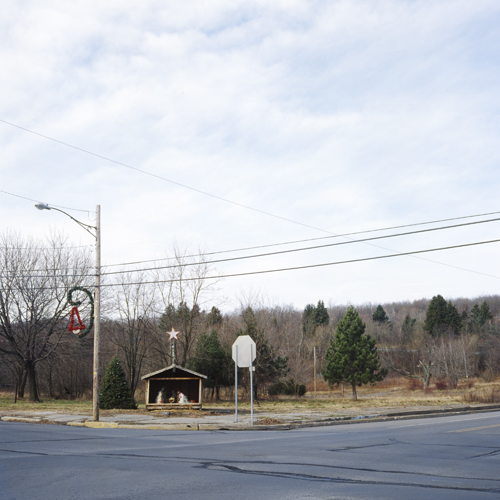
One of my favorite books about Centralia is Slow Burn: A Photodocument of Centralia, Pennsylvania by Renee Jacobs. Jacobs lived with a family in Centralia as the issues in the early and mid 80's started to develop. An intimate look into the lives of the former residents, it portrays the huge divide between those who wanted to stay and those who wanted to leave. The book documents the fight for and eventual loss of the community. It is powerful and well-written and stands as one of the few sources about the town of Centralia and what was lost to the fires.
David DeKok's Unseen Danger is currently sitting on my book shelf. It is an in-depth, text-only look at what really happened there and how the people of the town came together to secure a future that didn't involve gas alarms in their kitchens and bedrooms.
I still think that, in context to where Centralia is, the story is unsurprising. The weight of being in Centralia is no different than the weight of being in any other part of the Coal Region. It blends into the strip mines and culm piles, a mere blip on the screen of your windshield if you're not paying attention to road signs.
It is no secret that I am totally obsessed with the Pennsylvania Anthracite Coal Region. I've posted about it before and talked about it at great length, but I thought this would be a good place to start this blog.
at
2:41 PM
![]()
labels: ghost town, pennsylvania, photography, silver, the coal region
Subscribe to:
Posts (Atom)
